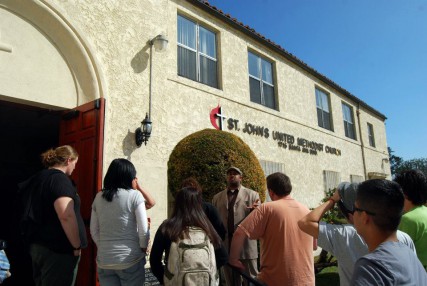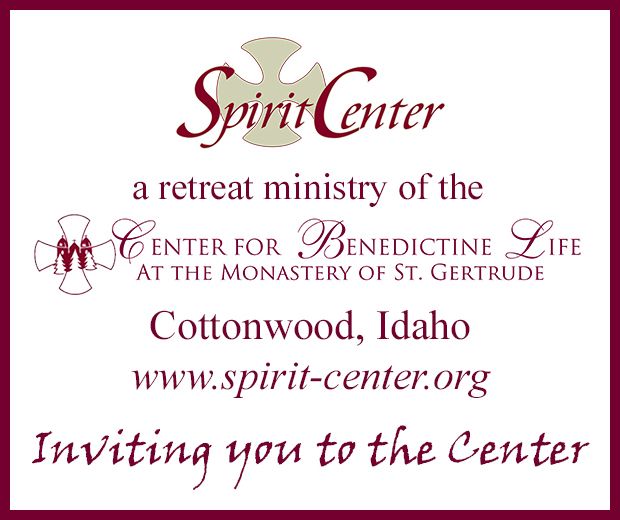
Sixteen volunteers representing The Wesley Foundation at Washington State University traveled to Los Angeles for Spring Break. As a member of this team, I witnessed firsthand the damage and despair left by decades of poverty, racial tension and negligence inflicted upon a large segment of Los Angeles’ population. But I also witnessed the courage of those working to uplift the downtrodden, and the hope and determination of those living in such dire circumstances.
Our team left from Spokane on March 11. That evening we were be introduced to our base of operations for the week: Vermont Square Methodist Church. While “aging labyrinth” might be an apt description of the rundown church, the large basement/recreation room that came to be our living quarters certainly felt like home every time I returned from another hard day’s work.
The organization hosting our mission trip was the Sierra Service Project. A nonprofit based in California, we had three Sierra Service Project employees acting as our guides, mentors and cooks for the week.
Monday, Wednesday and Friday were our work days. The mission trip group was divided into two teams of eight and sent to separate work sites on these days: Team Van-Nessa and Team Van-Morrison — representing the two mini-vans we rented, one for each team.
My team, Van-Morrison, was tasked with renovating an old garage adjacent to a Methodist church in the infamous Watts neighborhood. Our job was to remove the items currently inhabiting the garage, start putting insulation and drywall over the bare wooden walls, prep the walls for painting and remove the garage door to be replaced with a proper door.
Over the course of those three work days, my team and I became familiar with construction tools and terms most of us did not know, but we proved to be a surprisingly efficient team. The bonding process was a little slow on the first day. Half of us were strangers to one another, both within our smaller team and the mission trip group in general. That all changed by lunchtime, however, as we bonded over a dropped sandwich and an amorous pigeon.
You had to be there.

Tuesday was our first learning day. All of us were taken on a bus tour of South Central Los Angeles, going from Watts to downtown Los Angeles. All the while our tour guide, a retired pastor, gave us a history lesson of the city’s long history of poverty, immigration and racial tension — focusing on the Watts Riots of 1965 and the Rodney King Riots of 1992.
We ate lunch at Mama’s Tamales, a restaurant that also serves as a kitchen for street vendors to prepare their meals for free before hitting the streets. From there, we made our way to a part of downtown known as Skid Row.
Skid Row is occupied by more than 6,000 homeless people. Other than the multiple missions and shelters operated there, Skid Row is a largely desolate area where you won’t find anyone but the homeless.
We were divided into groups of four and made to participate in a simulation in which we were members of a homeless family in need of shelter, food, showers and clothing.
This is how we got to experience Skid Row, walking the streets and interacting with many desperate people. While some gave us strange, even nasty, glances and sarcastic remarks, others were genuinely interested in what we were doing and glad to see us. Many displayed a sense of determination in picking themselves up and overcoming their current situation.
We finished that day in a much quieter, reflective mood than after the work on Monday. For all of us, this was a side of Los Angeles we were not used to.
Wednesday we returned to our prospective work sites for another long day of work. This was probably the most exhausting day for me as I wound up balancing drywall with my head as we placed it on the ceiling.
Thursday we got another tour, starting with a visit to Homeboy Industries, an organization that rehabilitates ex-cons into society by finding them jobs. We then got a more thorough tour of Watts. We were introduced to a group attempting to refurbish people’s homes using special artistic touches and to the pastor of the church my team had been working.
Honestly, I found Watts surprisingly homey. The area reminded of my old San Francisco neighborhood, which has never been a particularly upscale neighborhood. Although there was a sobering reminder of Watts’ continuing problems when we discovered a local gang member had decided to use the garage door of our work site as his personal billboard, sending some sort of graffiti message to his rivals.
Friday was our last full day of work. My team managed to finish all of our goals except for replacing the garage door. Instead we painted over the graffiti from the day before.
Saturday morning we left with heavy hearts; sad to leave after so many memories — some fond and joyful, others depressing or enraging. We all experienced varying degrees of shock at the conditions in South Central Los Angeles.
For myself, at least, I have hope. I realize we were but a small link in a bigger chain of people putting time and energy into strengthening Los Angeles. Even though our week of work has passed, I know other teams are already picking up where we left off. Little by little, the citizens of Los Angeles can all enjoy a taste of God’s mercy and love with the help of their fellow man and woman.





